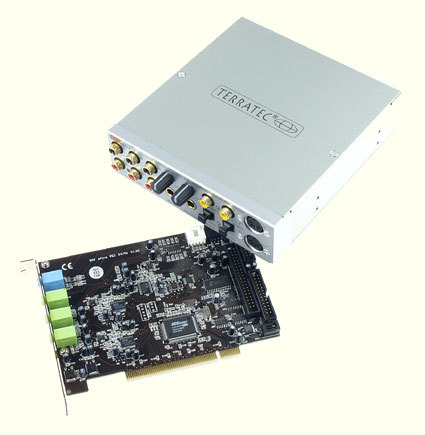Terratec DMX 6Fire 24/96 vs. Sound Blaster Audigy Platinum
Terratec DMX 6Fire 24/96
| Terratec DMX6Fire 24/96 | |
|---|---|
| Manufacturer | Terratec |
| Interface | PCI |
| DSP | IC Ensemble Envy 24 |
| Sound quality | 24 bits/96 kHz |
| Inputs / Outputs | |
| Card Inputs | Line In, Mic In |
| Rack Inputs | Line In, Phono in, Mic In, Midi In, Optical and Coaxial In |
| Card Outputs | Mini-jack Front, Back, LFE + Central |
| Rack Output | Headphones, Midi Out, Line Out, Optical and Coaxial Out |
| 3D capabilities | |
| Standards supported | DS3D, A3D 1.x, EAX 1.0/2.0 |
| 3D sound management | 2.1, 4.1 and 5.1 |
| Number of voices - hardware/software | 32/16 |
| Music capabilities | |
| MIDI characteristics | FM Synthesis |
| Capacities | NA |
| Number of voices - hardwareNumber of voices - software | 064 |
| AD signal-to-noise ratio | 100 dB |
| DA signal-to-noise ratio | 104 dB |
| Price | $249 |
The DMX 6Fire 24/96 evolved from the EWX 24/96, and is based on an ICE1712-BBABA revision of an Envy 24 DSP by IC Ensemble. The card we tested is a 1.2C revision, i.e., the final retail version of the card as you will find in stores. Unlike the Creative Labs Audigy, the Envy 24 is a fully 24 bit/ 96 kHz compatible DSP. It supports 2 x 12 simultaneous digital or analog inputs/ outputs. This means the DSP manages 12 mono inputs and 12 mono outputs. Note that only 10 of the 12 inputs or outputs are 24 bit/ 96 kHz-compatible. The chip includes a 36 bit hardware digital mixer to ensure that none of the 24 bit channels loses in dynamic frequency. The most striking difference with the Audigy is that the Envy 24 is not, strictly speaking, a DSP, but more like the chips on video adapters or the old Aureal Vortex 2s. Note, too, that the DMX 6Fire 24/96 does not have an AC'97 codec.
The Envy 24 has AKM 4524VF, Philips 74HC4316D analog-to-digital (AD) and digital-to-analog (DA) converters, and a Cirrus Logic CS8427-CS chip for managing S/PDIF inputs/ outputs. This and the converters both support sound sampled at 96 kHz without exception, and the card needs no software or hardware Sample Rate Conversion. So you can input 24 bit/ 96 kHz sound in analog or digital form, edit it and play it back in digital or analog with a sample rate ranging from 11 to 96 kHz. In addition, as the card works mainly in digital, any incoming analog signal is converted into PCM 24 bit digital sound first.
The card's Midi capabilities are minimal since it has no Wave table (sound samples) or Midi management system; it performs only a simple software emulation. Terratec justifies this choice with the argument that the DMX 6Fire 24/96 is designed to be integrated into a complete sound system and does not aspire to the same versatility as the Audigy Platinum. The Terratec card is focused on a more "professional" market, and is more expensive because you need the extra hardware in order to take advantage of its full potential.
The multimedia functions of the DMX 6Fire 24/96 are quite extensive. Its hardware supports 16-voice Direct Sound and handles A3D 1.x standards via DS3D, EAX 1.0 and 2.0. Its 3D engine is a Sensaura. Unlike the EAX, the Sensaura is absolutely not an API. Its technology operates mainly using DS3D and EAX instructions. So there are no games optimized for Sensaura, but any game using DS3D will benefit from it. And don't try and find a Sensaura-made chip on the card either, everything is in the software. The company develops 3D sound technologies and sells the licenses to sound card manufacturers.
The DMX 6Fire 24/96 can also decode Dolby Digital or DTS sound (software decoding) from a DVD video. It can also be connected to 5.1 speakers without an ad hoc decoder to take advantage of Home Cinema. The card comes with the following: Power DVD 3.0 and Sound Laundry software to process sound from vinyl records; Wavelab Lite 2.0 for recording; and a control panel developed by Terratec.
Get Tom's Hardware's best news and in-depth reviews, straight to your inbox.
Current page: Terratec DMX 6Fire 24/96
Prev Page Introduction Next Page Terratec DMX 6Fire 24/96: Drivers